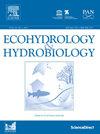利用生物废料减轻入侵水葫芦(Pontederia crassipes)水华系统中沉积磷的交换通量
IF 2.2
4区 环境科学与生态学
Q2 ECOLOGY
引用次数: 0
摘要
富钙材料已被研究作为沉积物封盖剂,但高成本和外来金属离子成分的潜在毒性已被确定为现场规模应用的障碍。因此,以钙矿物相为主的生物源废弃物腹足类壳(GS)可作为水华系统中的沉积物封盖剂。利用从一个石笋水华系统中采集的上覆水和沉积物样品,对经过热处理的石笋的磷结合能力进行了评价。创建了两个微观水生系统(即缺氧和缺氧系统),其中GS修正和未修正的沉积物。系统孵育50天,监测其理化特性的时间变化趋势,以及沉积物-水界面的养分交换通量。概念验证是在银幕上用盆栽实验进行的。两种活性物质对水相和沉积物相P均有显著的固存能力,但GS1000的固存能力更好。GS修正泥沙截留了沉淀的磷,阻止了磷向上覆水体释放,但上覆水体pH值显著升高。在田间试验中,GS1000改良泥沙降低了沉淀磷的交换通量,导致白蛉在24天内死亡。建议进一步研究泥沙修正所产生的极端pH值对白杨生长剖面的影响。本文章由计算机程序翻译,如有差异,请以英文原文为准。
Mitigating the exchange flux of sedimented phosphorus in invasive water Hyacinth (Pontederia crassipes) bloom system using a biogenic waste material
Calcium rich materials have been studied as sediment capping agents, but the high cost and the potential toxicity of extraneous metal ion constituents have been identified as impediments to field-scale applications. Therefore, Gastropod shell (GS), a biogenic waste material predominated with calcium mineral phase is assessed as a sediment capping agent in P. crassipes bloom system. Using the overlying water and sediment samples collected from a P. crassipes bloom system, the P-binding capacity of thermally treated GS was evaluated. Two microcosm aquatic systems (i.e., oxic and anoxic systems), with GS amended and unamended sediment, were created. The systems were incubated for fifty (50) days and the temporal trend in the physicochemical characteristics, and nutrient exchange flux across the sediment-water interface were monitored. The proof-of-concept was tested using pot experiment in a screenhouse. The two reactive materials showed significant capacity to sequestrate both the aqueous and sediment phase P, but the GS1000 showed better performance. The GS amended sediment trapped the sedimented P, and precluded the release into the overlying water phase, but a significant increase in the pH value of the overlying water was noted. In the field trial, the GS1000 amended sediment mitigated the exchange flux of sedimented P, which led to the death of the P. crassipes within twenty-four (24) days. Further studies are recommended to ascertain the role of extreme pH value created by the sediment amendment on the growth profile of P. crassipes.
求助全文
通过发布文献求助,成功后即可免费获取论文全文。
去求助
来源期刊

Ecohydrology & Hydrobiology
Agricultural and Biological Sciences-Aquatic Science
CiteScore
5.40
自引率
3.80%
发文量
51
期刊介绍:
Ecohydrology & Hydrobiology is an international journal that aims to advance ecohydrology as the study of the interplay between ecological and hydrological processes from molecular to river basin scales, and to promote its implementation as an integrative management tool to harmonize societal needs with biosphere potential.
 求助内容:
求助内容: 应助结果提醒方式:
应助结果提醒方式:


